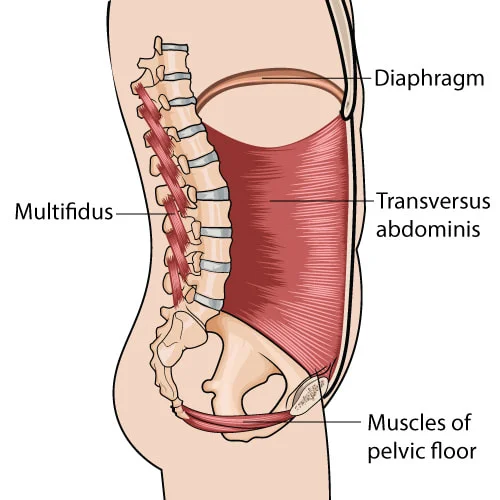The Core
The Core
When you think of the core of something, you probably think of the inner part of an object - like the core of an apple, or the core of the earth... or something that is central to the existence of something like ‘the core beliefs’ of a religion. When it comes to the human body, many claim that there is a set of muscles that are of vital importance, especially when it comes to back pain. But is it helpful to define ‘The Core?’
This article will examine this idea of the core muscles, if they should be labelled ‘the core’, whether they are more important than any other muscles, and whether core muscle training is useful for low back pain.
What is the core?
The core muscles garnered hype during the 1990’s when researchers linked back pain with a lack of ‘core stability’. Since then, many therapists have advised clients with back pain to selectively ‘activate’ their core muscles to treat their pain. However, identifying and testing these muscles has proven to be very difficult.
A universally accepted definition of ‘the core’ is lacking. Sometimes the core is said to consist of all the muscles in the trunk - between the shoulders and the pelvis. Other times, there is a heightened focus on the smaller ‘local’ muscles, deep in the abdomen such as the transversus abdominus, multifidus and pelvic floor muscles.

Words are important
The words we use can have a big impact on how we feel and our behaviour. For example, you may go to a physiotherapist and they say to you: “You have wear and tear in your knee joint”. If they then prescribe some exercises that might be painful initially, you’re much less likely to continue due to thoughts of causing more wear and tear to the joint. Contrast that to the therapist saying “You have some age related changes in your knee, which have become sensitive due to you doing more than you are used to. We need to increase the capacity of your knee joint so it’s more resilient”. You would be much more likely to persist with the exercises because you don’t have thoughts of your knee joint grinding away like the joint in a car. The same can be said for back pain. If a physiotherapist tells you “your spine is unstable, we need to work on your core stability”, you may have a belief that your spine is fragile, and needs to be protected with a hyperfocus on the core muscles. It would arguably be much better for you if the therapist told you “your back is sensitive at the moment, but it’s not damaged, and it’s still very strong. Here are some simple exercises to get your back used to moving again while it settles down.
Pain is a very complex phenomenon. It is not, as commonly believed, as simple as tissue damage = pain (read more here). Our thoughts, attitudes and beliefs, as demonstrated above, can have a big impact on our pain experience. When we use words like core stability training, we run the risk of inducing harmful beliefs. Similarly, using a title like “the core” may lead to a belief that you must have a strong core before you lift anything, or that the core muscles are more important than the others. This is why, at Be Mobile we avoid the word core and prefer a title like “trunk muscles”.
Are the core muscles more important than others?
At present, for the vast majority of back pain cases, there is not one identifiable structure that is causing symptoms. This is where the diagnosis “non-specific low back pain” comes from and it encompasses around 90% of low back pain cases. If we can’t identify one structure causing symptoms, it’s unlikely that a specific, targeted approach to treatment is having a mechanical effect on pain. As mentioned above, pain is incredibly complex, and exercise might be helpful for lots of reasons beyond changing anything mechanically.
We have good evidence that any form of exercise is beneficial for back pain, and people who are more physically active have reduced risk of having back pain. You can read more about that here. There is absolutely nothing wrong with ‘core exercises’. In fact, at Be Mobile we often include exercises specifically challenging the muscles around our abdomen, but just remember that they don’t have any special benefits for back pain beyond general exercise and you don’t NEED to do them - your spine is strong and robust on it’s own. They may, however, be a good starting point if your back is particularly sensitive.
Conclusion
The idea of a specific set of ‘core muscles’ came about from an erroneous assumption that the spine is inherently unstable and needs securing by a certain group of muscles. This idea is advanced when we encourage the belief that the core muscles are special and need to be focused on, and this happens whenever we give them a special name “The core”. Finally, back pain is a complex problem beyond mere mechanical changes, and we should spend our time and energy on educating ourselves, and performing exercise that we enjoy, rather than hyper-focusing on “The Core”.
References:
Dickson, C. (2021). Core Stability: Does it Matter? | Barbell Medicine. Retrieved 13 July 2021, from https://www.barbellmedicine.com/blog/core-stability-does-it-matter/
Hodges, P., & Richardson, C. (1996). Inefficient Muscular Stabilization of the Lumbar Spine Associated With Low Back Pain. Spine, 21(22), 2640-2650. doi: 10.1097/00007632-199611150-00014
Lederman, E. (2021). The Myth of Core Stability. Retrieved 13 July 2021, from https://www.cpdo.net/Lederman_The_myth_of_core_stability.pdf
Lehman, G. (2021). Core stability and pain: Is it time to stop using the word stability to explain pain? — Greg Lehman. Retrieved 13 July 2021, from http://www.greglehman.ca/blog/2012/12/26/core-stability-and-pain-time-to-stop-using-this-word-to-explain-pain


